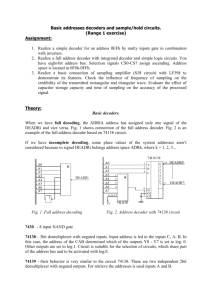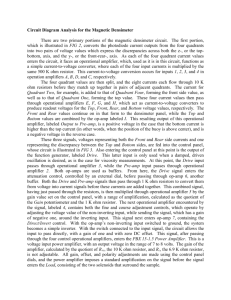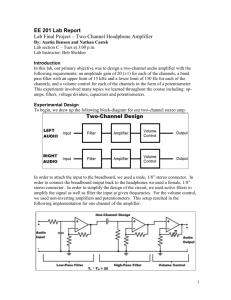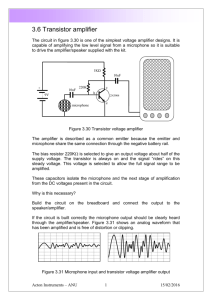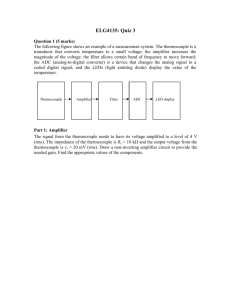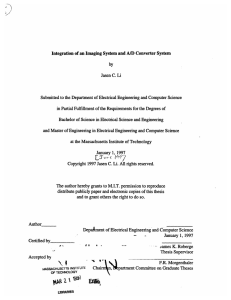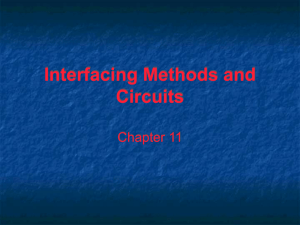Sensors and calibration handout
advertisement
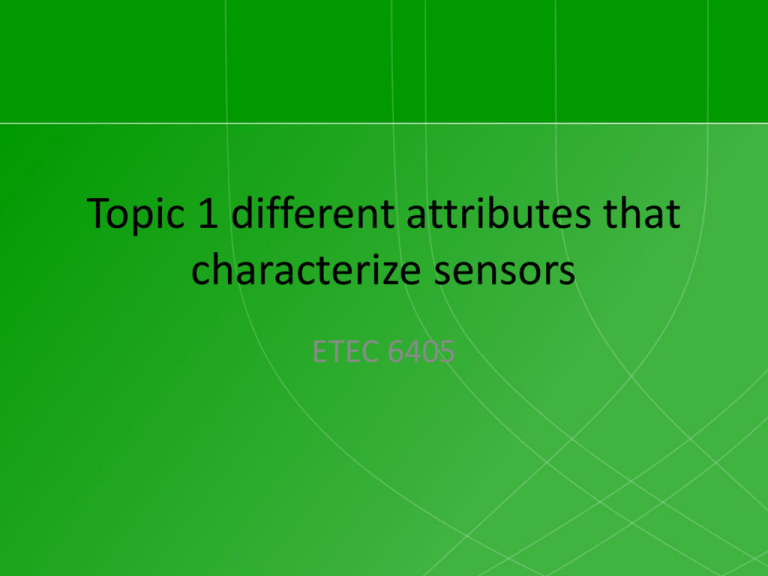
Topic 1 different attributes that characterize sensors ETEC 6405 Sensors and transducers • Analogue signal– this is a continuous signal. • Sensors measure physical phenomenon. Some physical processes are – • Angular or linear position • Acceleration • Temperature • Pressure • Stress • Light intensity • Sound Properties by which we characterize sensors • -Accuracy: maximum difference between the indicated and the actual reading. Maximum error or accuracy Problem A sensor with an accuracy of 10 mm has a position reading of 1.34 meters. What is the maximum and minimum possible readings for this sensor based on the sensors accuracy? Resolution • Resolution: used in systems that step through readings. The smallest increment the sensor can detect. resolution length Measurements from A sensor span a distance of 3 meters in 50 increments. What is the resolution? • Repeatability: When a sensor measurement is repeated and there are errors associated with the measurement, we can use a standard deviation to describe repeatability. • Linearity: A linear relationship between the input phenomena of the device relative to the output to another device • Precision: Considers accuracy, repeatability of the device relative to another device • Range: Natural limits of a sensor. • Dynamic Response: frequency range for a sensor, i.e. from 1KHz to 10KHz. • Calibration: this is the relationship between the input phenomena and the sensor output. • Cost: sensor pricing, generally more precision equals more cost. • Environment: Factors which affect the sensor performance i.e. humidity, temp, etc Angular Displacement • Potentiometers • The wiper moves across the resistive film, changing the resistance between V1 and V2 • Potentiometers are used as voltage dividers Encoder disk • There are two types of encoder disks, relative encoders and absolute encoders Tacogenerator • If ω is the angular velocity of the shaft, the output voltage of the tachometer is given by • where k is the gain constant of the tachometer. Variable reluctance tachometer • When the magnetic moves past a stationary pick-up coil, current is induced. • For each rotation of the shaft there is a pulse in the coil. • This technique often requires some signal • conditioning circuitry Strain gauges • Strain gauges measure stress-strain in a material by measuring the resistance in a small piece of wire • The resistance of a wire is a function of the length, width and thickness. When the wire is stretched, these parameters will change. • We relate the change in resistance to strain/stress Wheatstone bridge Temperature sensors • Thermistors are used in low- to mediumtemperature applications, ranging from −50 ◦C to about +200 ◦C. • RTDs are used in medium-range temperature measurements, ranging from −200 ◦C to+600 ◦C. • thermocouples are best suited to very low and very high temperature measurements. The typical measuring range is from −270 ◦C to +2600 ◦C. • Integrated circuit temperature sensors are used in low-temperature applications, ranging from −40 ◦C to +125 ◦C. The LM35DZ, manufactured by National Semiconductors Inc. This is a 3-pin analogue output sensor which provides a linear output voltage of 10 mV/◦C. The temperature range is 0 ◦C to +100 ◦C, with an accuracy of +/-1.5 ◦C. Thermister • Thermistors are non-linear devices, their resistance will decrease with an increase in temperature. • They are constructed from metal oxide semiconductors Thermister instrumentation circuit Thermocouple • Thermocouples use a junction of dissimilar • metals to generate a voltage proportional to temperature • The basic calculations for thermocouples provides the measured voltage using a reference temperature and a constant specific to the device Equation characterizing a thermocouple Thermocouple classes An instrumentation rig • Often the signal from the transducer needs to be modified by a signal conditioner before it enters the control system Signal conditioning • Signals from transducers are typically too small to be read by a normal analogue input card or a MCU • We often use signal conditioning to obtain a signal of suitable size and format for the Analogue to digital process • Signal conditioners often contain amplifier circuits. • There are many many different amplification circuits that use operational amplifiers. • Instrumentation amplifier circuits often have some capacity to change the gain and offset. • What is important is that you know what the common ones are, how they are used and how to derive the gain for the amplifier circuit Definitions • Gain – ratio that relates the input signal entering the amplifier to the output signal leaving the amplifier • There are two types of gains • Voltage gain • 𝛽 = 𝑉𝑜𝑢𝑡 𝑉𝑖𝑛 – given as a dimensionless constant • Power gain (Pout/Pin) – given in decibels G(dB)=10 log(Pout /(Pin)) or G(dB)=20 log(Vout /(Vin)) Offset • The offset in an amplifier circuit is obtained by changing the value of a resistor. This adds a linear value to the output of the amplifier Inverting amplifier • 𝑉𝑜𝑢𝑡 = − 𝑅𝑓 𝑅𝑖𝑛 𝑉𝑖𝑛 where the gain 𝛽 = − 𝑅𝑓 𝑅𝑖𝑛 Non inverting amplifier • 𝑉𝑜𝑢𝑡 = 𝑉𝑖𝑛 1 + 𝑅2 𝑅1 Voltage follower • 𝑉𝑜𝑢𝑡 = 𝑉𝑖𝑛 Summing amplifier • The summing amplifier produces an inverted output Single ended signal amplifier • Inverting amplifier with adjustable gain and offset Differential voltage amplifier Under the condition that the Rf/R1 = Rg/R2, the output expression becomes 𝑉𝑜𝑢𝑡 =𝛽(𝑉2 -𝑉1 ) where 𝛽~ 𝑅𝑓 𝑅1 is the differential gain of the circuit Alternative differential amplifier • Differential amplifier with current converted to voltage input • The circuit below will convert a differential (double ended) signal to a single ended signal. • The two input op-amps are used as unity gain followers, to create a high input impedance. • The following amplifier amplifies the voltage difference Comparator • A comparator is constructed using an operational amplifier. • The comparators output is Bistable (Vs+ or Vs-). • The output indicates which of the two inputs has a higher voltage.


